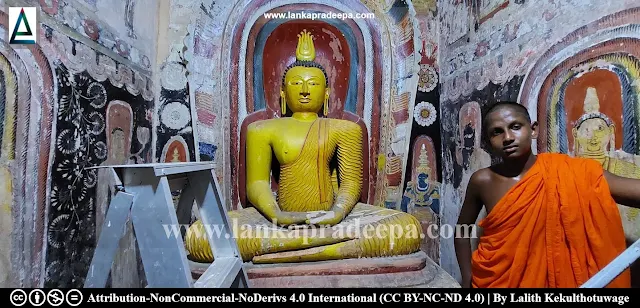
Watagedara Tempita Viharaya, also known as Sri Sudharshanarama Pothgul Viharaya (Sinhala: වටගෙදර ටැම්පිට විහාරය), is a Buddhist temple situated in Watagedara village in Matara District, Sri Lanka.
History
The Tempita Viharaya of this temple was constructed by Totagedara Ganinnanse during the reign of King Sri Vijaya Rajasinha [(1739-1747 A.D.) Silva & Chandrasekara, 2021].
Tempita Viharaya
Tempita Viharas were popular in many Buddhist temples during the Kandyan Period. These structures were usually built on a wooden platform resting on bare stone pillars or stumps which are about 1-4 feet tall. The roof is generally made of timber and held by wooden stumps. The walls are usually made of wattle and daub and form the main enclosed shrine room containing Buddhist sculptures and murals in the Kandyan style. Some Tempita Viharas have narrow verandas and ambulatories circulating the main enclosed space. The construction of these buildings started in the 17th century and lasted until the end of the 19th century (Wijayawardhana, 2010).
Watagedara Tempita Viharaya

The square-shaped Tempita Viharaya of Watagedara temple has been built on 8 short stone pillars about 2 ft. in height (Silva & Chandrasekara, 2021). The ambulatory has been built on the ground level and the roof in front of the structure extends out than the other three sides to provide shade for the entrance door. The ambulatory is completely enclosed by walls and its outer surfaces have been moulded to form niches and base mouldings (Silva & Chandrasekara, 2021). The entries to the ambulatory and to the Tempita structure are perpendicular to each other.
The outer and inner surfaces of the sanctum's walls are painted with Buddhist themes such as Buddha Charitaya (incidents of the life of Buddha), Suvisi Vivaranaya (Buddha to be receiving the blessing from 24 previous Buddhas).

.
Attribution
#) LankaPradeepa.com would like to thank Lalith Kekulthotuwage for providing the necessary photographs required for this article. All the photos are published here with the permission of the author.
References
1) Silva, K.D. and Chandrasekara, D.P., 2021. The Tämpiṭavihāras of Sri Lanka: Elevated Image-Houses in Buddhist Architecture. Anthem Press. pp.156-157.
2) Wijayawardhana, K., 2010. Sri Lankawe Tampita Vihara (In Sinhala). Dayawansa Jayakody & Company. Colombo. ISBN: 978-955-551-752-2. p.12.
2) Wijayawardhana, K., 2010. Sri Lankawe Tampita Vihara (In Sinhala). Dayawansa Jayakody & Company. Colombo. ISBN: 978-955-551-752-2. p.12.
Explore Other Nearby Attractions
Location Map (Google)
This page was last updated on 8 October 2023

